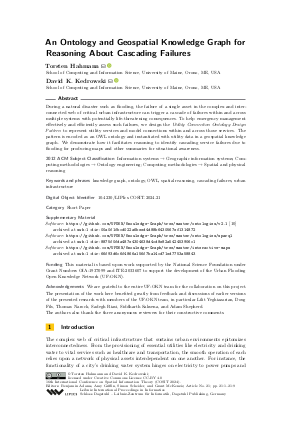An Ontology and Geospatial Knowledge Graph for Reasoning About Cascading Failures (Short Paper)
Authors
Torsten Hahmann  ,
David K. Kedrowski
,
David K. Kedrowski 
-
Part of:
Volume:
16th International Conference on Spatial Information Theory (COSIT 2024)
Part of: Series: Leibniz International Proceedings in Informatics (LIPIcs)
Part of: Conference: Conference on Spatial Information Theory (COSIT) - License:
 Creative Commons Attribution 4.0 International license
Creative Commons Attribution 4.0 International license
- Publication Date: 2024-09-09
File

PDF
LIPIcs.COSIT.2024.21.pdf
- Filesize: 1.85 MB
- 9 pages
Document Identifiers
Subject Classification
ACM Subject Classification
- Information systems → Geographic information systems
- Computing methodologies → Ontology engineering
- Computing methodologies → Spatial and physical reasoning
Keywords
- knowledge graph
- ontology
- OWL
- spatial reasoning
- cascading failures
- urban infrastructure
Metrics
- Access Statistics
-
Total Accesses (updated on a weekly basis)
0PDF Downloads0Metadata Views
Abstract
During a natural disaster such as flooding, the failure of a single asset in the complex and interconnected web of critical urban infrastructure can trigger a cascade of failures within and across multiple systems with potentially life-threatening consequences. To help emergency management effectively and efficiently assess such failures, we design the Utility Connection Ontology Design Pattern to represent utility services and model connections within and across those services. The pattern is encoded as an OWL ontology and instantiated with utility data in a geospatial knowledge graph. We demonstrate how it facilitates reasoning to identify cascading service failures due to flooding for producing maps and other summaries for situational awareness.
Cite As Get BibTex
Torsten Hahmann and David K. Kedrowski. An Ontology and Geospatial Knowledge Graph for Reasoning About Cascading Failures (Short Paper). In 16th International Conference on Spatial Information Theory (COSIT 2024). Leibniz International Proceedings in Informatics (LIPIcs), Volume 315, pp. 21:1-21:9, Schloss Dagstuhl – Leibniz-Zentrum für Informatik (2024)
https://doi.org/10.4230/LIPIcs.COSIT.2024.21
BibTex
@InProceedings{hahmann_et_al:LIPIcs.COSIT.2024.21,
author = {Hahmann, Torsten and Kedrowski, David K.},
title = {{An Ontology and Geospatial Knowledge Graph for Reasoning About Cascading Failures}},
booktitle = {16th International Conference on Spatial Information Theory (COSIT 2024)},
pages = {21:1--21:9},
series = {Leibniz International Proceedings in Informatics (LIPIcs)},
ISBN = {978-3-95977-330-0},
ISSN = {1868-8969},
year = {2024},
volume = {315},
editor = {Adams, Benjamin and Griffin, Amy L. and Scheider, Simon and McKenzie, Grant},
publisher = {Schloss Dagstuhl -- Leibniz-Zentrum f{\"u}r Informatik},
address = {Dagstuhl, Germany},
URL = {https://drops.dagstuhl.de/entities/document/10.4230/LIPIcs.COSIT.2024.21},
URN = {urn:nbn:de:0030-drops-208364},
doi = {10.4230/LIPIcs.COSIT.2024.21},
annote = {Keywords: knowledge graph, ontology, OWL, spatial reasoning, cascading failures, urban infrastructure}
}
Author Details
Funding
This material is based upon work supported by the National Science Foundation under Grant Numbers OIA-1937099 and ITE-2033607 to support the development of the Urban Flooding Open Knowledge Network (UF-OKN).
Acknowledgements
We are grateful to the entire UF-OKN team for the collaboration on this project. The presentation of the work here benefited greatly from feedback and discussions of earlier versions of the presented research with members of the UF-OKN team, in particular Lilit Yeghiazarian, Doug Fils, Thomas Narock, Sadegh Riasi, Siddharth Saksena, and Adam Shepherd. The authors also thank the three anonymous reviewers for their constructive comments.
Supplementary Materials
-
Software
https://github.com/UFOKN/Knowledge-Graph/tree/master/ontologies/v2.1
Torsten Hahmann, David K. Kedrowski. OWL Ontologies for the Urban Flooding Open Knowledge Network (UF-OKN) (Software). Schloss Dagstuhl – Leibniz-Zentrum für Informatik (2024) https://doi.org/10.4230/artifacts.22447
browse
 archived version
archived version
-
Software
https://github.com/UFOKN/Knowledge-Graph/tree/master/ontologies/sparql
browse
 archived version
archived version
-
Software
https://github.com/UFOKN/Knowledge-Graph/tree/master/interactive-maps
browse
 archived version
archived version
References
-
Sören Auer, Jens Lehmann, and Sebastian Hellmann. Linkedgeodata: Adding a spatial dimension to the web of data. In Intern. Semantic Web Conference (ISWC), pages 731-746. Springer, 2009.

-
Eva Blomqvist, Torsten Hahmann, Karl Hammar, Pascal Hitzler, Rinke Hoekstra, Raghava Mutharaju, et al. Advances in pattern-based ontology engineering. IOS Press, 2021.

-
Sergey V. Buldyrev, Roni Parshani, Gerald Paul, H. Eugene Stanley, and Shlomo Havlin. Catastrophic cascade of failures in interdependent networks. Nature, 104:1025-1029, 2010.

-
Neil Carhart and Ges Rosenberg. A framework for characterising infrastructure interdependencies. international journal of complexity in applied science and technology. Intern. J. of Complexity in Applied Science and Technology, 1:35-60, 2016.

-
Arkadiusz Chadzynski, Nenad Krdzavac, Feroz Farazi, Mei Qi Lim, Shiying Li, Ayda Grisiute, Pieter Herthogs, Aurel von Richthofen, Stephen Cairns, and Markus Kraft. Semantic 3D city database — an enabler for a dynamic geospatial knowledge graph. Energy and AI, 6, 2021.

-
Alishiba Dsouza, Nicolas Tempelmeier, Ran Yu, Simon Gottschalk, and Elena Demidova. WorldKG: A world-scale geographic knowledge graph. In Intern. Conf. on Inf. & Knowledge Mgmt (CIKM), pages 4475-4484. ACM, 2021.

-
Heshan Du, Lijun Wei, Vania Dimitrova, Derek Magee, Barry Clarke, Richard Collins, David Entwisle, Mehran Eskandari, Giulio Curioni, Ross Stirling, Helen Reeves, and Anthony G. Cohn. City infrastructure ontologies. Comput. Environ. Urban Syst., 104, 2023.

-
Aldo Gangemi. Ontology design patterns for semantic web content. In 4th Int. Semantic Web Conf., 2005.

-
Torsten Hahmann. Ontology repositories: A treasure trove for content ontology design patterns. In Proc. of the Workshop on Modular Ontologies (WoMO 2014), CEUR Workshop Proceedings, Vol. 1248, 2014.

-
Torsten Hahmann and David K. Kedrowski. OWL Ontologies for the Urban Flooding Open Knowledge Network (UF-OKN). Software, version 2.1., (visited on 2024-08-28). URL:
https://github.com/UFOKN/Knowledge-Graph/tree/master/ontologies/v2.1
 archived version
archived version
full metadata available at: https://doi.org/10.4230/artifacts.22447 -
Krzysztof Janowicz, Pascal Hitzler, Wenwen Li, Dean Rehberger, Mark Schildhauer, Rui Zhu, et al. Know, Know Where, KnowWhereGraph: A densely connected, cross-domain knowledge graph and geo-enrichment service stack for applications in environmental intelligence. AI Magazine, 43(1):30-39, 2022.

-
J Michael Johnson, Tom Narock, Justin Singh-Mohudpur, Doug Fils, Keith Clarke, Siddharth Saksena, Adam Shepherd, Sankar Arumugam, and Lilit Yeghiazarian. Knowledge graphs to support real-time flood impact evaluation. AI Magazine, 43(1):40-45, 2022.

-
Min Ouyang. Review on modeling and simulation of interdependent critical infrastructure systems. Reliability Engineering & System Safety, 121:43-60, 2014.

-
Basel Shbita, Craig A. Knoblock, Weiwei Duan, Yao-Yi Chiang, Johannes H. Uhl, and Stefan Leyk. Building spatio-temporal knowledge graphs from vectorized topographic historical maps. Semantic Web, 2023.

